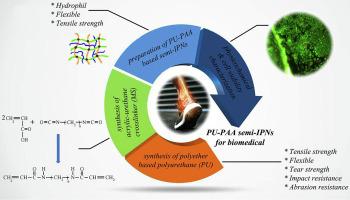当前位置:
X-MOL 学术
›
Eur. Polym. J.
›
论文详情
Our official English website, www.x-mol.net, welcomes your feedback! (Note: you will need to create a separate account there.)
Synthesis and characterization of biocompatible semi-interpenetrating polymer networks based on polyurethane and cross-linked poly (acrylic acid)
European Polymer Journal ( IF 6 ) Pub Date : 2020-11-01 , DOI: 10.1016/j.eurpolymj.2020.109974 Soheil Zenoozi , Gity Mir Mohamad Sadeghi , Mahsa Rafiee
European Polymer Journal ( IF 6 ) Pub Date : 2020-11-01 , DOI: 10.1016/j.eurpolymj.2020.109974 Soheil Zenoozi , Gity Mir Mohamad Sadeghi , Mahsa Rafiee

|
Abstract Semi-interpenetrating polymer networks (semi-IPNs) of polyether-based polyurethane (PU)/cross-linked poly (acrylic acid) (PAA) were synthesized with different PAA content. The PAA was cross-linked by a novel acrylic-urethane diene monomer synthesized by the condensation reaction of hexamethylene diisocyanate (HDI) and acrylic acid (AA). The resulting PU-PAA semi-IPNs were characterized using Fourier transform infrared spectroscopy (FTIR), scanning electron microscopy (SEM), thermogravimetric analysis (TGA), and tensile measurements. The presence of urethane groups in the cross-linking agent led to better interactions between PAA and PU. Elongation at break of the semi-IPNs increased by increasing the PAA content, while there is a decrease in tensile modulus and strength. PU-PAA-5 had the highest tensile strain, of 1240%. The hydrophobicity of the prepared specimens was investigated by the contact angle drop test and water absorption. The results showed that the hydrophilicity was increased by increasing the PAA content in the semi-IPNs. For PU-PAA-0 to PU-PAA-35, the water contact angle decreased from 82 to 57°. Also confirmed by Methylthiazol tetrazolium (MTT) assay and cell staining, the hydrophilicity directly affected the biocompatibility of the semi-IPNs. These results showed that the PU-PAA semi-IPNs could be a suitable biocompatible material for diverse medical applications.
中文翻译:

基于聚氨酯和交联聚(丙烯酸)的生物相容性半互穿聚合物网络的合成和表征
摘要 合成了具有不同 PAA 含量的聚醚基聚氨酯 (PU)/交联聚丙烯酸 (PAA) 的半互穿聚合物网络 (semi-IPNs)。PAA 由一种新型丙烯酸-氨基甲酸酯二烯单体交联,该单体通过六亚甲基二异氰酸酯 (HDI) 和丙烯酸 (AA) 的缩合反应合成。使用傅里叶变换红外光谱 (FTIR)、扫描电子显微镜 (SEM)、热重分析 (TGA) 和拉伸测量对所得 PU-PAA 半 IPN 进行表征。交联剂中氨基甲酸酯基团的存在导致 PAA 和 PU 之间更好的相互作用。随着 PAA 含量的增加,半 IPNs 的断裂伸长率增加,而拉伸模量和强度降低。PU-PAA-5 的拉伸应变最高,为 1240%。通过接触角下降试验和吸水率研究制备的样品的疏水性。结果表明,通过增加半 IPNs 中 PAA 的含量来增加亲水性。对于 PU-PAA-0 到 PU-PAA-35,水接触角从 82°降低到 57°。甲基噻唑四唑 (MTT) 测定和细胞染色也证实,亲水性直接影响半 IPNs 的生物相容性。这些结果表明 PU-PAA 半 IPNs 可能是一种适合各种医学应用的生物相容性材料。甲基噻唑四唑 (MTT) 测定和细胞染色也证实,亲水性直接影响半 IPNs 的生物相容性。这些结果表明 PU-PAA 半 IPNs 可能是一种适合各种医学应用的生物相容性材料。甲基噻唑四唑 (MTT) 测定和细胞染色也证实,亲水性直接影响半 IPNs 的生物相容性。这些结果表明 PU-PAA 半 IPNs 可能是一种适合各种医学应用的生物相容性材料。
更新日期:2020-11-01
中文翻译:

基于聚氨酯和交联聚(丙烯酸)的生物相容性半互穿聚合物网络的合成和表征
摘要 合成了具有不同 PAA 含量的聚醚基聚氨酯 (PU)/交联聚丙烯酸 (PAA) 的半互穿聚合物网络 (semi-IPNs)。PAA 由一种新型丙烯酸-氨基甲酸酯二烯单体交联,该单体通过六亚甲基二异氰酸酯 (HDI) 和丙烯酸 (AA) 的缩合反应合成。使用傅里叶变换红外光谱 (FTIR)、扫描电子显微镜 (SEM)、热重分析 (TGA) 和拉伸测量对所得 PU-PAA 半 IPN 进行表征。交联剂中氨基甲酸酯基团的存在导致 PAA 和 PU 之间更好的相互作用。随着 PAA 含量的增加,半 IPNs 的断裂伸长率增加,而拉伸模量和强度降低。PU-PAA-5 的拉伸应变最高,为 1240%。通过接触角下降试验和吸水率研究制备的样品的疏水性。结果表明,通过增加半 IPNs 中 PAA 的含量来增加亲水性。对于 PU-PAA-0 到 PU-PAA-35,水接触角从 82°降低到 57°。甲基噻唑四唑 (MTT) 测定和细胞染色也证实,亲水性直接影响半 IPNs 的生物相容性。这些结果表明 PU-PAA 半 IPNs 可能是一种适合各种医学应用的生物相容性材料。甲基噻唑四唑 (MTT) 测定和细胞染色也证实,亲水性直接影响半 IPNs 的生物相容性。这些结果表明 PU-PAA 半 IPNs 可能是一种适合各种医学应用的生物相容性材料。甲基噻唑四唑 (MTT) 测定和细胞染色也证实,亲水性直接影响半 IPNs 的生物相容性。这些结果表明 PU-PAA 半 IPNs 可能是一种适合各种医学应用的生物相容性材料。


























 京公网安备 11010802027423号
京公网安备 11010802027423号